The Stomach Cancer Market is estimated to be valued at USD 7.0 billion in 2025 and is projected to reach USD 14.0 billion by 2035, registering a compound annual growth rate (CAGR) of 7.2% over the forecast period.
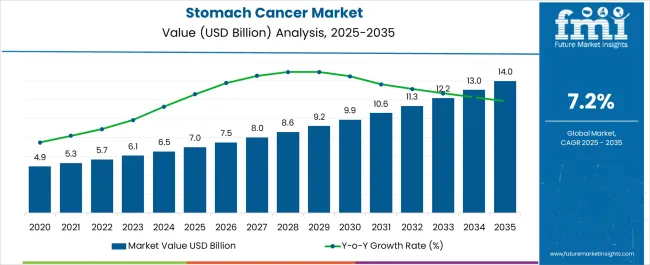
| Metric | Value |
|---|---|
| Stomach Cancer Market Estimated Value in (2025 E) | USD 7.0 billion |
| Stomach Cancer Market Forecast Value in (2035 F) | USD 14.0 billion |
| Forecast CAGR (2025 to 2035) | 7.2% |
The stomach cancer market is experiencing steady growth, driven by the rising global prevalence of gastric malignancies and the increasing focus on early detection and improved treatment outcomes. The growing incidence of risk factors such as unhealthy dietary patterns, smoking, and Helicobacter pylori infections is contributing to higher case volumes worldwide. Advancements in diagnostic imaging, biomarker-based screening, and molecular pathology are enabling earlier identification of the disease, which is supporting better clinical outcomes.
Investment in oncology infrastructure and the availability of advanced therapies across emerging economies are also shaping the market’s expansion. Increasing adoption of minimally invasive surgical procedures and targeted drug regimens is reducing recovery times and improving patient survival rates.
Rising healthcare expenditure, supportive government initiatives, and enhanced awareness campaigns are further contributing to treatment demand As innovation continues in immunotherapy and precision medicine, the market is expected to witness significant growth, with opportunities for improved treatment strategies that offer greater efficacy and fewer side effects.
The stomach cancer market is segmented by treatment type, end-user, and geographic regions. By treatment type, stomach cancer market is divided into Surgery, Targeted drugs therapy, Sunitinib (Sutent), Trastuzumab (Herceptin), Imatinib (Gleevec), Chemo Therapy, Adjuvant chemotherapy, and Radiation therapy. In terms of end-user, stomach cancer market is classified into Hospitals, Clinics, Specialized Cancer Treatment Centers, and Ambulatory Surgical Centers. Regionally, the stomach cancer industry is classified into North America, Latin America, Western Europe, Eastern Europe, Balkan & Baltic Countries, Russia & Belarus, Central Asia, East Asia, South Asia & Pacific, and the Middle East & Africa.
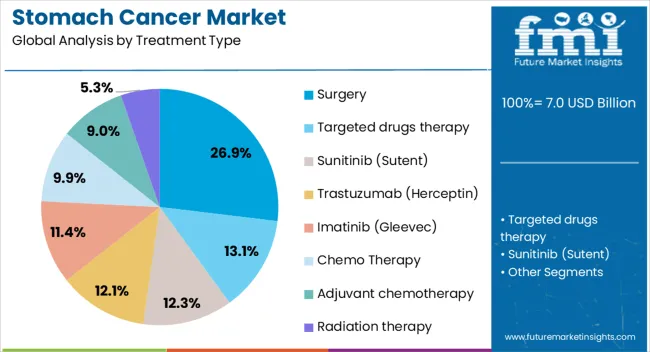
The surgery segment is expected to account for 26.9% of the stomach cancer market revenue share in 2025, establishing it as the leading treatment type. This leadership is being reinforced by the procedure’s role as the most effective option for patients with localized or resectable gastric tumors, where complete tumor removal significantly improves survival outcomes. Technological advancements in minimally invasive and laparoscopic surgical techniques have reduced post-operative complications, shortened hospital stays, and improved recovery times, driving patient preference and physician recommendation.
The adoption of surgical interventions is also supported by the integration of advanced imaging and robotic-assisted platforms, which allow greater precision and reduced trauma during procedures. Rising awareness among healthcare providers regarding early intervention has further boosted demand for surgical treatments.
As multidisciplinary treatment approaches gain prominence, surgery remains the cornerstone of therapy for curative intent, complemented by chemotherapy and targeted therapies Its cost-effectiveness, combined with proven long-term survival benefits, is expected to sustain its dominant role in the market over the forecast period.
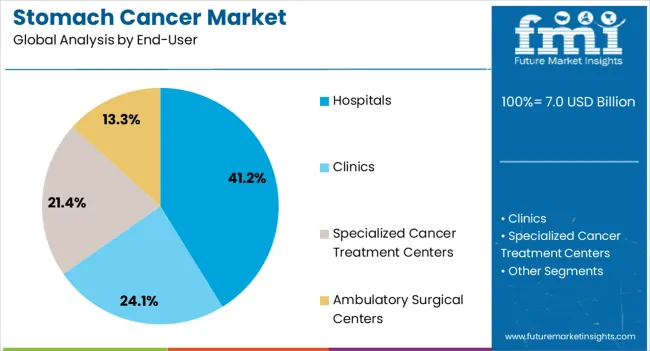
The hospitals segment is projected to hold 41.2% of the stomach cancer market revenue share in 2025, making it the largest end-user category. This leadership is being driven by the concentration of specialized oncology departments, advanced surgical infrastructure, and multidisciplinary care teams within hospital settings. Hospitals are equipped to provide comprehensive treatment plans that combine surgery, chemotherapy, radiation therapy, and targeted biologics, making them the preferred choice for both patients and healthcare providers.
The availability of advanced diagnostic technologies, robotic-assisted surgical systems, and intensive post-operative care units further strengthens their position in managing complex gastric cancer cases. Rising hospital investments in oncology research and clinical trials are also expanding access to cutting-edge therapies, including immunotherapy and precision medicine approaches.
The growing number of patient admissions, coupled with the central role hospitals play in early diagnosis and treatment pathways, reinforces their dominance As cancer treatment continues to evolve toward integrated and personalized care, hospitals are expected to remain at the forefront of delivering high-quality, outcome-focused stomach cancer treatments.
Stomach Cancer is a fourth most common cancer globally in which malignant (cancer) cells form in the lining of the stomach. Major cause for the developing stomach cancer is not known exactly, But bacterium Helicobacter pylori is one of the main cause of stomach cancer.
Smoking and ulcer are few factors leading to stomach cancer. Other factors such as age, diet, and stomach disease can affect the risk of developing stomach cancer. Symptoms of stomach cancer include indigestion and stomach discomfort or pain.
Tests that examine the stomach and esophagus are used to detect (find) and diagnose Stomach cancer. Certain factors affect prognosis (chance of recovery) and treatment options. Stomach cancer is the fifth most widely prevalent cancer in the world causing almost 700,000 deaths globally per year.
Stomach cancer market is growing rapidly due to increasing incidence of adenocarcinoma, lymphoma and gastrointestinal stromal tumors across the globe. Major drivers for the stomach cancer market are treatment advancements, combination therapies, increasing number of cancer treatment centers, large number of regulatory approvals for metastatic gastric cancer and low dose radiation technology based devices.
Furthermore, the launch of novel therapies for metastatic stomach cancer is expected to drive the growth of the market in the near future. However lack of adequate financial assistance from health insurance policies and stringent regulatory procedures for approving complex nature of radiation devices are the major factors that can hamper the stomach cancer market growth over the forecast period.
Other factors such as high cost of therapy and commercially less availability of drugs for the treatment of stomach cancer may hinders the global stomach cancer market.
Stomach Cancer market is growing with a significant CAGR due to its high adoption rate in patient specific treatment of gastric cancer by most recent treatment options from surgery to chemotherapy. Developing countries are growing with a higher CAGR compared to other parts of the world.
By end use, hospitals and specialized cancer treatment centers segments are expected to account for around 50% share in the global stomach cancer market and the trend is forecast to continue through 2026. Based on treatment type, targeted therapy is expected to register above average CAGR over the forecast period owing to providing innovative techniques such as stem cell therapy, immunotherapy or enzyme therapy.
Depending on geographic region, global stomach cancer market is segmented into seven key regions: North America, South America, Eastern Europe, Western Europe, Asia Pacific Excluding Japan, Japan, and Middle East & Africa. Asia-Pacific followed by Latin America are the leading markets for stomach cancer treatment market owing to the large patient base of stomach cancer.
According to the World Cancer Research Fund International, in 2025, Japan accounted for the largest market share of approximately 24.7% in the global stomach cancer treatment market due to high consumption of salty and pickled foods. It's not just Japan (31.1 new cases /100,000), other countries such as South Korea (41.4), China (29.9), and Mongolia (34) have very high incidence rates of stomach cancer.
In the year 2025, 354,829 cases of stomach cancer were diagnosed in China which makes the country a lucrative market for stomach cancer treatment. However, stomach cancer treatment market in North America and Africa is expected to witness sluggish growth due to low incidence rate of stomach cancer.
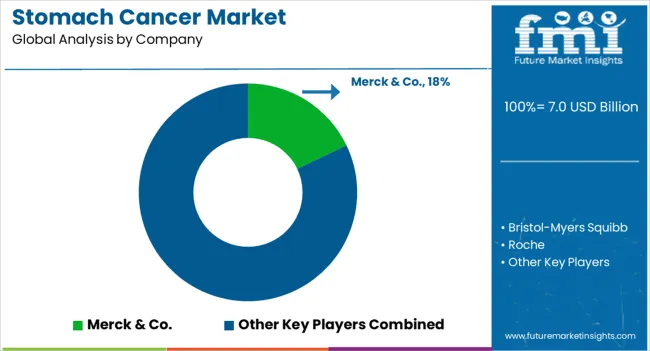
Key players in the Stomach Cancer Market include Eli Lilly and company, F. Hoffmann-La Roche Ltd., GlaxoSmithKline plc, Merck KGaA, Novartis International AG and Otsuka Holdings Co. Ltd.
The research report presents a comprehensive assessment of the market and contains thoughtful insights, facts, historical data, and statistically supported and industry-validated market data. It also contains projections using a suitable set of assumptions and methodologies. The research report provides analysis and information according to categories such as market segments, geographies, types, technology and applications.
The report is a compilation of first-hand information, qualitative and quantitative assessment by industry analysts, inputs from industry experts and industry participants across the value chain. The report provides in-depth analysis of parent market trends, macro-economic indicators and governing factors along with market attractiveness as per segments. The report also maps the qualitative impact of various market factors on market segments and geographies.
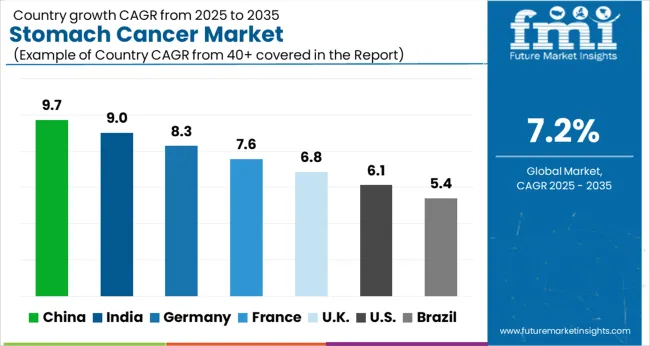
| Country | CAGR |
|---|---|
| China | 9.7% |
| India | 9.0% |
| Germany | 8.3% |
| France | 7.6% |
| UK | 6.8% |
| USA | 6.1% |
| Brazil | 5.4% |
The Stomach Cancer Market is expected to register a CAGR of 7.2% during the forecast period, exhibiting varied country level momentum. China leads with the highest CAGR of 9.7%, followed by India at 9.0%. Developed markets such as Germany, France, and the UK continue to expand steadily, while the USA is likely to grow at consistent rates. Brazil posts the lowest CAGR at 5.4%, yet still underscores a broadly positive trajectory for the global Stomach Cancer Market. In 2024, Germany held a dominant revenue in the Western Europe market and is expected to grow with a CAGR of 8.3%. The USA Stomach Cancer Market is estimated to be valued at USD 2.6 billion in 2025 and is anticipated to reach a valuation of USD 4.8 billion by 2035. Sales are projected to rise at a CAGR of 6.1% over the forecast period between 2025 and 2035. While Japan and South Korea markets are estimated to be valued at USD 358.0 million and USD 219.9 million respectively in 2025.
| Item | Value |
|---|---|
| Quantitative Units | USD 7.0 Billion |
| Treatment Type | Surgery, Targeted drugs therapy, Sunitinib (Sutent), Trastuzumab (Herceptin), Imatinib (Gleevec), Chemo Therapy, Adjuvant chemotherapy, and Radiation therapy |
| End-User | Hospitals, Clinics, Specialized Cancer Treatment Centers, and Ambulatory Surgical Centers |
| Regions Covered | North America, Europe, Asia-Pacific, Latin America, Middle East & Africa |
| Country Covered | United States, Canada, Germany, France, United Kingdom, China, Japan, India, Brazil, South Africa |
| Key Companies Profiled | Merck & Co., Bristol-Myers Squibb, Roche, Eli Lilly, Pfizer, AstraZeneca, Novartis, and Amgen |
The global stomach cancer market is estimated to be valued at USD 7.0 billion in 2025.
The market size for the stomach cancer market is projected to reach USD 14.0 billion by 2035.
The stomach cancer market is expected to grow at a 7.2% CAGR between 2025 and 2035.
The key product types in stomach cancer market are surgery, targeted drugs therapy, sunitinib (sutent), trastuzumab (herceptin), imatinib (gleevec), chemo therapy, adjuvant chemotherapy and radiation therapy.
In terms of end-user, hospitals segment to command 41.2% share in the stomach cancer market in 2025.






Our Research Products

The "Full Research Suite" delivers actionable market intel, deep dives on markets or technologies, so clients act faster, cut risk, and unlock growth.

The Leaderboard benchmarks and ranks top vendors, classifying them as Established Leaders, Leading Challengers, or Disruptors & Challengers.

Locates where complements amplify value and substitutes erode it, forecasting net impact by horizon

We deliver granular, decision-grade intel: market sizing, 5-year forecasts, pricing, adoption, usage, revenue, and operational KPIs—plus competitor tracking, regulation, and value chains—across 60 countries broadly.

Spot the shifts before they hit your P&L. We track inflection points, adoption curves, pricing moves, and ecosystem plays to show where demand is heading, why it is changing, and what to do next across high-growth markets and disruptive tech

Real-time reads of user behavior. We track shifting priorities, perceptions of today’s and next-gen services, and provider experience, then pace how fast tech moves from trial to adoption, blending buyer, consumer, and channel inputs with social signals (#WhySwitch, #UX).

Partner with our analyst team to build a custom report designed around your business priorities. From analysing market trends to assessing competitors or crafting bespoke datasets, we tailor insights to your needs.
Supplier Intelligence
Discovery & Profiling
Capacity & Footprint
Performance & Risk
Compliance & Governance
Commercial Readiness
Who Supplies Whom
Scorecards & Shortlists
Playbooks & Docs
Category Intelligence
Definition & Scope
Demand & Use Cases
Cost Drivers
Market Structure
Supply Chain Map
Trade & Policy
Operating Norms
Deliverables
Buyer Intelligence
Account Basics
Spend & Scope
Procurement Model
Vendor Requirements
Terms & Policies
Entry Strategy
Pain Points & Triggers
Outputs
Pricing Analysis
Benchmarks
Trends
Should-Cost
Indexation
Landed Cost
Commercial Terms
Deliverables
Brand Analysis
Positioning & Value Prop
Share & Presence
Customer Evidence
Go-to-Market
Digital & Reputation
Compliance & Trust
KPIs & Gaps
Outputs
Full Research Suite comprises of:
Market outlook & trends analysis
Interviews & case studies
Strategic recommendations
Vendor profiles & capabilities analysis
5-year forecasts
8 regions and 60+ country-level data splits
Market segment data splits
12 months of continuous data updates
DELIVERED AS:
PDF EXCEL ONLINE
Cancer Registry Software Market Size and Share Forecast Outlook 2025 to 2035
Cancer Biological Therapy Market Size and Share Forecast Outlook 2025 to 2035
Cancer Diagnostics Market Analysis - Size, Share and Forecast 2025 to 2035
Cancer Biopsy Market - Growth & Technological Innovations 2025 to 2035
Cancer Vaccines Market Analysis by Technology, Treatment Method, Application and Region from 2025 to 2035
Cancer Gene Therapy Market Overview – Trends & Future Outlook 2024-2034
Cancer-focused Genetic Testing Service Market Analysis – Growth & Industry Insights 2024-2034
Cancer Tissue Diagnostic Market Trends – Growth & Industry Forecast 2024-2034
Cancer Supportive Care Products Market Trends – Growth & Forecast 2020-2030
Cancer Antigens Market
Pet Cancer Therapeutics Market Insights - Growth & Forecast 2024 to 2034
Skin Cancer Detection Devices Market Size and Share Forecast Outlook 2025 to 2035
Lung Cancer Diagnostics Market Size and Share Forecast Outlook 2025 to 2035
Lung Cancer Surgery Market - Size, Share, and Forecast 2025 to 2035
Lung Cancer Therapeutics Market Analysis – Size, Share, and Forecast Outlook 2025 to 2035
Lung Cancer PCR Panel Market Trends, Growth, Demand & Forecast 2025 to 2035
Brain Cancer Diagnostics Market Size and Share Forecast Outlook 2025 to 2035
Liver Cancer Diagnostics Market Size and Share Forecast Outlook 2025 to 2035
Blood Cancer Treatment Market Growth – Trends & Forecast 2025 to 2035
Canine Cancer Screening Services Market Size and Share Forecast Outlook 2025 to 2035

Thank you!
You will receive an email from our Business Development Manager. Please be sure to check your SPAM/JUNK folder too.
Chat With
MaRIA